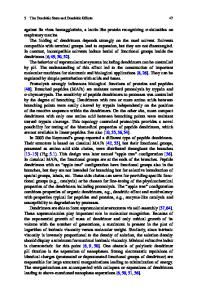New Dendritic Materials as Potential OLED Transport and Emitter Moeities
- PDF / 250,484 Bytes
- 6 Pages / 612 x 792 pts (letter) Page_size
- 45 Downloads / 395 Views
New Dendritic Materials as Potential OLED Transport and Emitter Moeities Asanga B. Padmaperuma1, Greg Schmett1, Daniel Fogarty1, Nancy Washton1, Sanjini Nanayakkara1, Linda Sapochak1, Kimba Ashworth2, Luis Madrigal2, Benjamin Reeves2, and Charles W. Spangler2 1 Department of Chemistry, University of Nevada, Las Vegas, Las Vegas, Nevada 89154-4003, USA. 2 Department of Chemistry and Biochemistry, Montana State University, Bozeman, MT 59717, USA. INTRODUCTION Traditionally, organic light-emitting devices (OLEDs) are prepared with discrete layers for hole and electron transport.1 Different materials must be used for these layers because most materials will preferentially transport one charge carrier more efficiently than the other. In most cases, the emitter material serves a dual purpose as both the emitter and the hole or electron transporter. One of the major failure modes of OLEDs results from thermal instabilities of the insulating organic layers caused by joule heating during device operation.2,3 The problem is most pronounced for the hole transporting layer (HTL) material which are usually tertiary aromatic amines (i.e., TPD and NPD). This has been attributed to the relatively lower glass transition temperatures (Tg) and resulting inferior thermal stabilities compared to the other materials making up the device.4,5 Many researchers have produced HTL materials with higher Tgs based on tertiary aromatic amine oligomers6 and starburst compounds.7 Starburst or model dendritic materials offer the advantages of high thermal stabilities and multi-functionality. Model dendrimers based on bis-(diphenylamino)-E-stilbene subunits as the dendrimer repeat units have been shown to form exceptionally stable bipolaronic dications upon oxidative doping.8,9 These charge states can also be photogenerated in the presence of electron acceptors on the picosecond time scale and are currently being evaluated as optical power limiters. Replacement of P for N reduces the capability for bipolaron formation, but substitution of only some of the N atoms in the dendrimer allows the preferential formation of polaronic radical cations.10 Thus design of the dendrimer can predetermine which charge states dominate the photophysical processes, a key factor in OLED design. Thus we anticipate that dendrimers based on bis-(diphenylamino) and bis-(diphenylphosphino) substituents incorporated into the dendrimer repeat units can possibly function as not only efficient hole transport materials, but also as emitters in various OLED design configurations. We present a study of the luminescence and thermal properties of bis(diphenylamino- and diphenylphosphino)-E-stilbene oligomers and model dendrimers and will illustrate the efficacy of controlling the P/N substitution patterns in the model dendrimers in terms of device performance.
Q3.9.1
OLIGOMERS N
MODEL DENDRIMERS N
N
3
STILD1
STIL1
P
N
P
P STIL2
N STILD2
3
Figure 1. Structures of bis(diphenylamino)- and bis(diphenylphosphino)-E-stilbene oligomers and model dendrimers. EXPERIMENTAL Materi
Data Loading...










